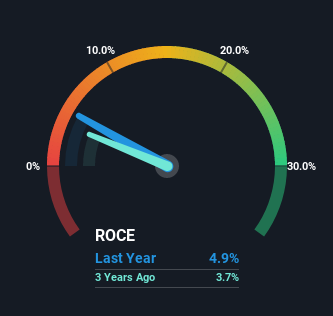Vilmorin & Cie (EPA:RIN) Has More To Do To Multiply In Value Going Forward
If you're looking for a multi-bagger, there's a few things to keep an eye out for. Firstly, we'd want to identify a growing return on capital employed (ROCE) and then alongside that, an ever-increasing base of capital employed. This shows us that it's a compounding machine, able to continually reinvest its earnings back into the business and generate higher returns. Having said that, from a first glance at Vilmorin & Cie (EPA:RIN) we aren't jumping out of our chairs at how returns are trending, but let's have a deeper look.
Return On Capital Employed (ROCE): What Is It?
For those who don't know, ROCE is a measure of a company's yearly pre-tax profit (its return), relative to the capital employed in the business. To calculate this metric for Vilmorin & Cie, this is the formula:
Return on Capital Employed = Earnings Before Interest and Tax (EBIT) ÷ (Total Assets - Current Liabilities)
0.049 = €137m ÷ (€3.6b - €790m) (Based on the trailing twelve months to June 2022).
Thus, Vilmorin & Cie has an ROCE of 4.9%. Even though it's in line with the industry average of 5.4%, it's still a low return by itself.
See our latest analysis for Vilmorin & Cie

Above you can see how the current ROCE for Vilmorin & Cie compares to its prior returns on capital, but there's only so much you can tell from the past. If you'd like to see what analysts are forecasting going forward, you should check out our free report for Vilmorin & Cie.
What The Trend Of ROCE Can Tell Us
The returns on capital haven't changed much for Vilmorin & Cie in recent years. Over the past five years, ROCE has remained relatively flat at around 4.9% and the business has deployed 23% more capital into its operations. This poor ROCE doesn't inspire confidence right now, and with the increase in capital employed, it's evident that the business isn't deploying the funds into high return investments.
The Key Takeaway
In summary, Vilmorin & Cie has simply been reinvesting capital and generating the same low rate of return as before. Since the stock has declined 27% over the last five years, investors may not be too optimistic on this trend improving either. In any case, the stock doesn't have these traits of a multi-bagger discussed above, so if that's what you're looking for, we think you'd have more luck elsewhere.
One more thing, we've spotted 2 warning signs facing Vilmorin & Cie that you might find interesting.
While Vilmorin & Cie isn't earning the highest return, check out this free list of companies that are earning high returns on equity with solid balance sheets.
New: Manage All Your Stock Portfolios in One Place
We've created the ultimate portfolio companion for stock investors, and it's free.
• Connect an unlimited number of Portfolios and see your total in one currency
• Be alerted to new Warning Signs or Risks via email or mobile
• Track the Fair Value of your stocks
Have feedback on this article? Concerned about the content? Get in touch with us directly. Alternatively, email editorial-team (at) simplywallst.com.
This article by Simply Wall St is general in nature. We provide commentary based on historical data and analyst forecasts only using an unbiased methodology and our articles are not intended to be financial advice. It does not constitute a recommendation to buy or sell any stock, and does not take account of your objectives, or your financial situation. We aim to bring you long-term focused analysis driven by fundamental data. Note that our analysis may not factor in the latest price-sensitive company announcements or qualitative material. Simply Wall St has no position in any stocks mentioned.
About ENXTPA:RIN
Vilmorin & Cie
Vilmorin & Cie SA creates, produces, and distributes vegetable and field seeds.
Undervalued with proven track record.
Similar Companies
Market Insights
Community Narratives




